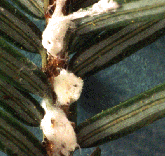|

Purple
Loosestrife,
(Lythrum salicaria).
Photo
Credit: U.S. Fish & Wildlife Service.
|
Non-indigenous
invasive plants, animals, and disease organisms cause increasing
harm to native species and significant economic losses by
reducing productivity and foreclosing opportunities for
beneficial uses of forests, croplands, rangelands, and aquatic
resources.
In
recent years, many species introduced decades ago have begun to
spread rapidly in U.S. ecosystems and pose increasing threats to
our Nation's lands and waters.
|

West
Nile Virus,
(Flavivirus sp.).
|
|

Zebra
Mussel, (Dreissena polymorpha) . Photo
Credit: Benson.
|
%20WERC.gif)
Saltcedar/Tamarisk, (Tamarix
sp.). Photo
Credit: USGS WERC.
|

Bullfrog,
(Rana
catesbeiana).
Photo
Credit: Bill Leonard.
|
|
USGS
plays an important role in Federal efforts to
combat invasive species
in natural and semi-natural areas through early detection and assessment
of newly established invaders, monitoring of invading populations, improving
understanding of the ecology of invaders and factors in the resistance
of habitats to
invasion, and development and testing of prevention, management and control methods.
|
|

Jack
Dempsey,
(Cichlasoma octofasciatum).
Photo
Credit: Leo Nico.
|

South
American Nutria,
(Mycastor coypus).
Photo
Credit: C.C. Lockwood.
|

Hemlock
Wooly Adelgid,
(Pseudoscymnus tsugae).
|
![]() Text-only
Text-only



%20WERC.gif)



